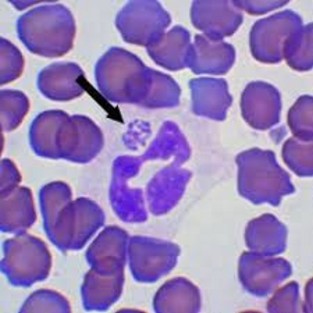Infection caused by the bacterium Anaplasma phagocytophilum, a Gram-negative bacterium that must be intracellular (it infects neutrophils), which is transmitted to humans by the bite of an Ixodes tick and is also the vector of Lyme borreliosis. Due to its non-specific symptomatology, the frequency of the disease is probably underestimated. Formerly known as human granulocytic erlichiosis.
Asymptomatic infections are common.
In symptomatic forms, the disease is characterized by a series of flu-like symptoms (fever, muscle pain, headache, abdominal symptoms), after an incubation period of 1 to 3 weeks.
Serious complications may arise: acute respiratory distress (atypical pneumonia), hemorrhage, rhabdomyolysis, renal failure or neurological problems.
The disease is accompanied by hematological disturbances: neutropenia, anemia and thrombocytopenia.
Pathognomonic image: presence of “morula” in polymorphonuclear cells.

Diagnosis: PCR test, serological tests, antibody detection tests, blood smear microscopy.
Treatment: doxycycline or rifampicin.
Anesthetic implications:
none known; depending on organs affected.
References :
-
Updated: November 2024